Although Kodak was probably most famous for its Retina and Retinette series, it built many other cameras including the Brownie range. Production of these and new post-war 35mm lines of cameras mostly took place in the U.S.A., including the following.
Kodak No. 2 Brownie
We'll start with a classic, by many considered the most important camera in history as it made photography affordable to the masses in the early 1900s. The Brownie was a box camera first introduced in 1900 as a very simple leather-covered cardboard camera with a meniscus lens and no viewfinder, and can thus be considered as the first point-and-shoot camera. It only cost $1, which was affordable for most people at the time, and quickly became hugely popular. Kodak sold millions of them, making money from the film they sold, not the actual cameras. Not dissimilar to the strategy employed these days by inkjet printer manufacturers!
A wide range of models were produced, using several different film formats. The No 2 Brownie used 120 rollfilm, which is still produced to this day, so this is the best model to go for if you want to try out this camera yourself. It was first introduced in 1904 and went through several incarnations until the start of WWII. After the war the name Brownie was used for more decorative box cameras as well as other cheap and popular, mostly plastic camera types.
Kodak No 2 Brownie model F from ca. 1931. (left) Side view showing the wind lever and viewfinder for when taking horizontal pictures. (top right) Front view showing two small viewfinders for when holding the camera horizontally or vertically, respectively. Note the lens opening, through which the lens itself is not visible as the shutter is located in front of it. (bottom right) Rear view showing the frame indicator for 120 roll film.
Kodak No. 2 Folding Autographic Brownie
Although most Kodak Brownies were box cameras, several different folding Brownies were also made. They were smaller than the box cameras and thus more portable, but also more expensive. From around 1914 the Autographic Brownies were introduced. They had a special and innovative feature, one could write comments on the film after each photo was taken. To facilitate this, the cameras came with a metal stylus and a small door at the back of the camera that allowed access to the paper-backed film roll. The camera needed to be loaded with special Autographic film, which had a thinner paper carrier but had a layer of carbon paper in-between the film and the paper. After inscribing the film with the stylus, it needed to be exposed to light for about 5 seconds. The written text would then appear on the developed negatives. See the Kodak Classics website for more info. Although the feature did not appear to be very popular, as little Autographic films with engravings are known to exist, at least a million folding Brownies were made up to 1926, when they were mostly phased out (but see the Kodak Six-20 Folding Brownie below).
A wide range of models existed covering a variety of film formats. Like the box Brownie, the No 2 Folding Brownie took the currently still available 120 rollfilm. It started production in September 1915. Early production had a rectangular body, but it received rounded edges from January 1917. Several varieties of the Autographic door existed (see Kodak Classics website above). The camera came with either a simple meniscus lens or a better Rectilinear lens. The shutter was a ball bearing model with 1/25, 1/50, B and T settings, whereas later production had a Kodex shutter.
(left) Kodak No 2 Folding Autographic Brownie from early 1916. Several numbers can be found on various camera parts, e.g., 10866 on the shutter, 10888 on the camera name plate and 5690 on the focus distance plate. However, the serial number of the camera was located on the lever that is used to open the camera front door. On this example it says 50,232, which indicates it was produced around January 1916. It is thus my oldest camera by quite a margin! Note that the shutter is an older style shutter pre-dating more commonly seen, later version which was marked 'Kodak Ball Bearing Shutter'.
(top right) Detail of shutter face showing various exposure markings as well as the simple 1-2-3-4 aperture scale. The lens on this example is a simple meniscus, which is located behind aperture and shutter (centre right) Autographic door and metal stylus to inscribe film, both held in place by the same latch. This is the early version of the door, found on models until March 1916 (bottom right) The camera shutter and body listed many patents, including these, some of which are listed on From the Focal Plane to Infinity.
Kodak No. 3a Autographic
This camera was essentially the big brother of the camera above. Most Kodak cameras from the first half of the 20th century, whether box or folding camera, came in a range of film formats so one could pick their favourite. For that purpose, Kodak also sold a large range of rollfilm formats. The Kodak No. 3a Autographic used 122 format, and on the photo below, where its wind spool is compared with a standard 120 spool, you can get an idea of its size. The format was 3 1/4 by 5 1/2" or 82 x 140 mm, which is close to the size of a standard postcard or 10x15 photo print, and therefore one could simply use a contact print to get a decent size photograph, with no need for an enlarger.
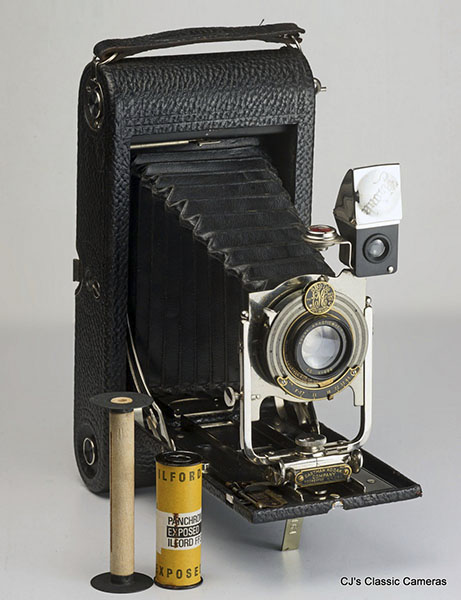
| |
Kodak No. 3a Autographic with Kodak Anastigmat f7.7 lens of unspecifed focal length in EKC Ball-bearing shutter. EKC stands for Eastman Kodak Company. The lens board could be moved up and down as well as left to right, so this was essentially a shift lens. It had a focussing rail for adjusting focus.
|
Kodak Vest Pocket
The Vest Pocket Kodaks were a hugely successful range of folding cameras for 127 rollfilm introduced in 1912. They were light and compact, yet delivered large 6x4 negatives. In fact, 127 film was developed by Kodak especially for this camera and was called Vest Pocket film originally. The Vest Pocket had a pull-out strut mechanism which was not as sturdy as the folding mechanism on the Folding Brownies, but it did the job and kept construction simple. Instead of a back door the camera could be loaded by removing the top. Shutters and lenses were similar to those on the Folding Brownies. In 1915 the Autographic version was introduced, which allowed notes to be engraved on the negatives (see the Folding Brownie above for details).
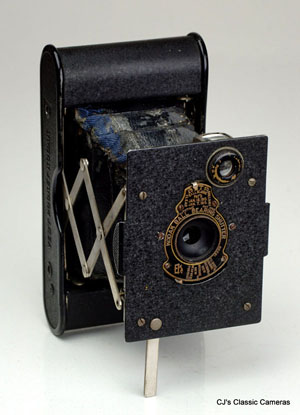
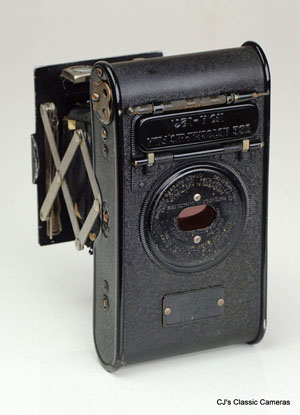
A Kodak Vest Pocket with a meniscus lens in a Kodak Ball Bearing shutter, which was a two-speed shutter that also had a B and T setting. This model also had an adjustable aperture. This particular example was a bit of a dud, it has many repairs to the bellows and part of the strut mechanism has become detached from the base board.
Kodak Vollenda 620
The Kodak Vollenda 620 was a 6x9 medium format camera for 620 rollfilm, which is similar to 120 film, but with a smaller diameter spool. The Vollenda was designed by Nagel Werke before it became part of Kodak in the early 1930s. It featured a brilliant finder, which is a small waistlevel viewfinder mounted next to the shutter, as well as a direct viewfinder. With a Compur shutter and a relatively fast f/4.5 lens it was a fairly well specified camera at the time.
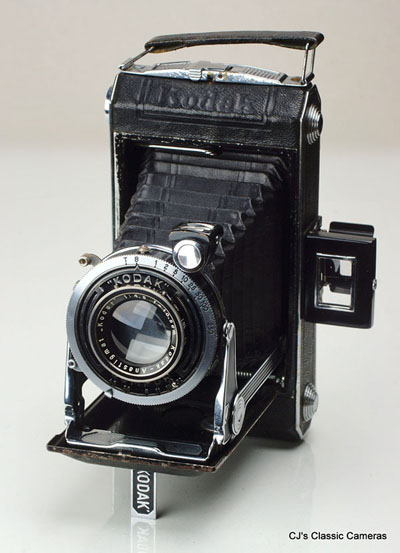
| |
A 1935 Kodak Vollenda 620 with Kodak-Anastigmat "Kodar" 105mm f/4.5 lens in Compur shutter. On this example the struts are slightly bend inward, so the lensboard is no longer parallel to the filmframe, a common problem with older folding cameras. In the manual it actually says that the camera may be damaged if the lens is not focussed to infinity when the front door is closed (!), so perhaps that's what happened.
Keen observers may notice a few features also visible on the Retina range, including the back door clasp and the camera support stand on the front door.
|
Kodak Duo 620
The Kodak Duo 620 was a half frame medium format film similar to the large range of 'Semi' cameras from Japan but fairly rare in Europe. As the name suggests, it used 620 film. The Duo 620 was introduced around 1934, around the same time as the first Retina. Early versions had a wind key, like the Nagel/Kodak Vollenda on which this camera was loosely based, later to be replaced by a wind knob. It was available with a choice of front-cell focussing or unit focussing lenses. In 1939 a rangefinder version with metal top housing was introduced, but production stopped with WWII and were never resumed after the war, so this last variant was built in only small numbers.
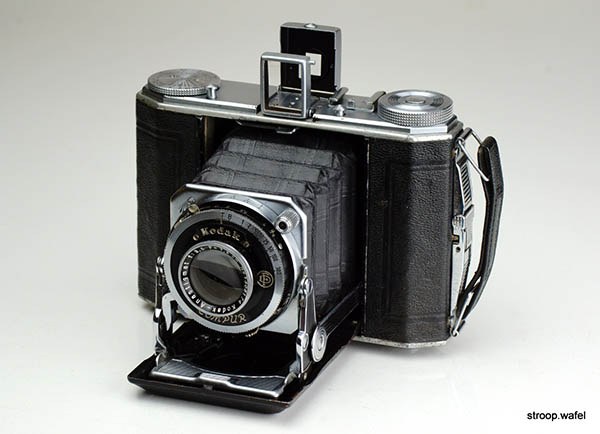
A Kodak Duo 620 Series II with unit-focussing Kodak-Anastigmat 75mm f/3.5 lens, which based on its serial number was probably a rebadged Schneider Xenar, with which the camera could also be equipped. This example is a French version based on the depth of focus dial on top of the camera.
Kodak Six-20 Folding Brownie
Here's another folding Brownie, a camera that looks like a true old-timer, but was in fact contemporary to most other cameras on this page: the Six-20 Folding Brownie. Rather curiously this model was made in Britain from around 1937-1940, and again as a slightly updated version (optical viewfinder instead of frame finder) from 1948-1954. It used 620 rollfilm, which was similar to 120 rollfilm but wound on a thinner spool.
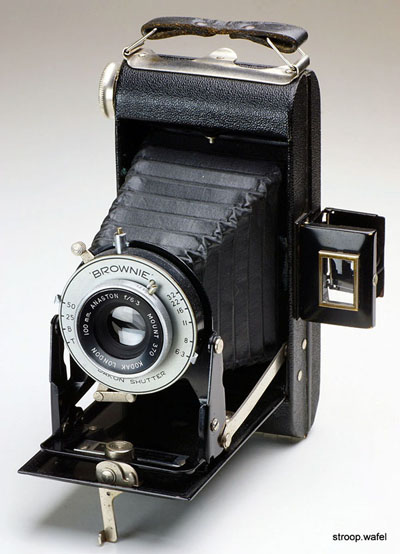 |
|
A late model Kodak Six-20 Folding Brownie with Kodak London Anaston 100mm f/6.3 lens in self-cocking Dakon shutter. |
Kodak Bantam Special
The Kodak Bantams were a range of cameras for the use of 828 roll film, which was similar in size to 35mm film but without perforations, so could expose a larger part of the film (40x28 mm instead of 36x24). The range was initially made up of various folding cameras, but was gradually replaced by rigid bodies. The 1936 Kodam Bantam Special could be considered a hybrid, as it's a folding camera but without the visible bellows of earlier models, but to simply see it as a transitional model would be a great injustice towards this magnificent camera. Instead, it's more appropriate to regard it as an attempt of the American branch of Kodak to produce a camera at least as capable as the Retinas coming out of the German branch. And what an attempt it was!
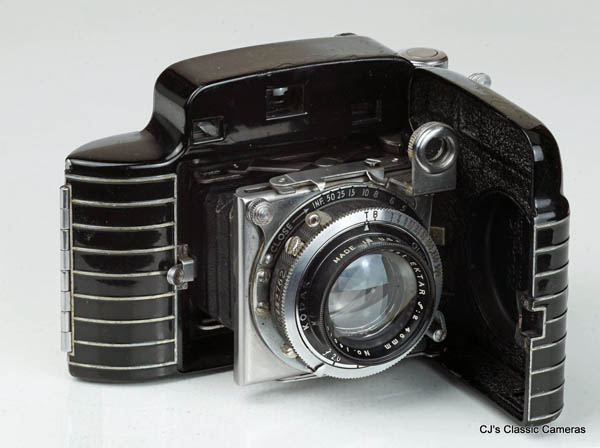
Kodak Bantam Special with Kodak Ektar 45 mm f/2 lens. It's worth realising that this camera was a contemporary of the Kodak Retina II type 142, one of the earliest Retina rangefinders, and if I had to make the choice at the time I may well have chosen the Bantam. Of course, with 828 film now being obsolete, it's a lot more unpractical.
Move mouse over the image to see it with the struts retracted and the camera door closed.
First of all, it's one of the more eye-catching cameras produced during this era, in Art Deco style made of black enamel with metal ribbing and sleek curves. Furthermore, it was a very well-made camera with an interesting coupled rangefinder design with an optic mounted on the lens board, reminiscent of the Zeiss Ikon Super Ikontas. It was equipped with a Kodak Ektar 45 mm f/2 lens, a six-element optic of Biotar/Xenon design with a great reputation and also found on a post-WWII Retina II variant (type 011, see here). In addition, it had various well though-out features such as a door hinge that was unlocked by rotating the lens focus beyond infinity, and a high magnification rangefinder window enabling very accurate focussing.
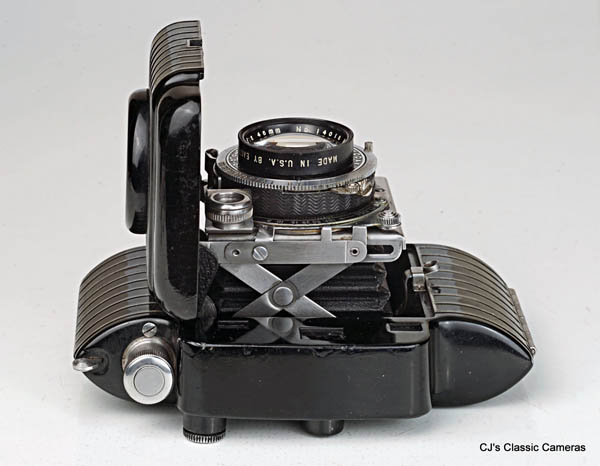
Top view of the Kodak Bantam Special, showing the strut design which was very similar to that of its cousin, the Retina.
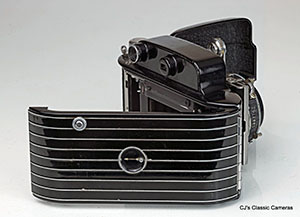
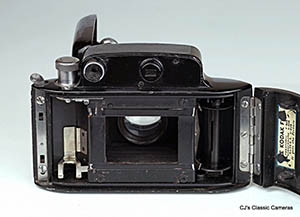
A couple more views of the Kodak Bantam Special, showing the camera back and its interior. It's a little ironic that this sleek camera was made at the same time in the same factory as the rather industrial looking Kodak 35 RF (see further below).
Kodak 35
The Kodak 35 was the first Kodak 35mm camera produced in the U.S.A., previously all 35mm cameras (the Retinas and Retinettes) had been made in Stuttgart, Germany. It was introduced in 1938 and had a bakelite body, one of the first cameras to be built this way, but probably based on the success of the Argus A series. It had two prominent wind knobs and a fold-up viewfinder. The latter seems a bit of a weak point, it doesn't secure well in place, so the image can be fuzzy until ones pushes the rear glass forward. There are several versions with different lens/shutter combinations, the main cosmetic change was that later models had a larger lens base.
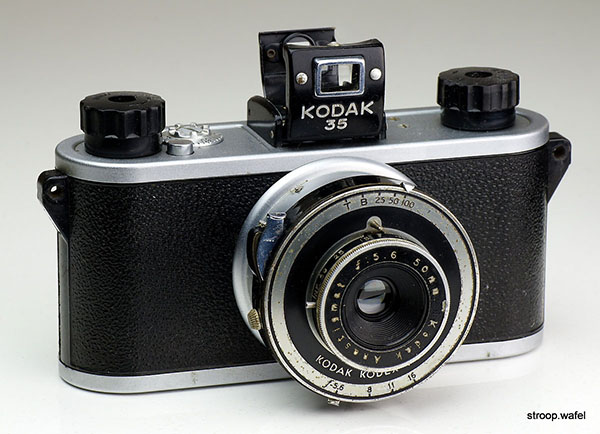
Early version of the Kodak 35 with 50mm f/5.6 Kodak Anastigmat lens in Kodex shutter. These are tricky to service as the shutter plate has no indents for tools to grip on, relying on friction instead. After many decades of non-use they tend to be completely stuck.
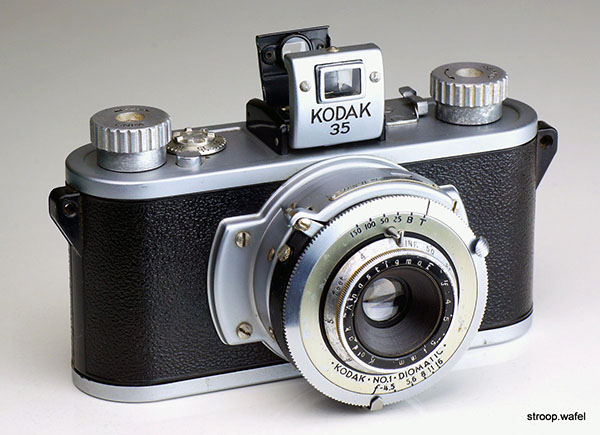
Later version of the Kodak 35 with 51mm (!) f/4.5 Kodak Anastigmat lens in Diomatic shutter. Note the larger lens base compared to the early version.
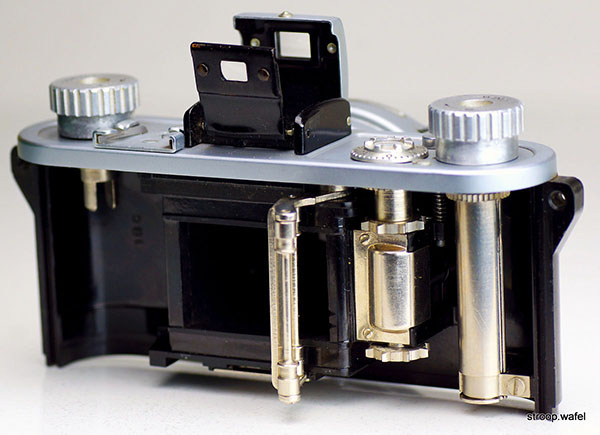
Wind mechanism of the Kodak 35.
In addition to the consumer models, there were also several specialty models of the Kodak 35, the most famous one probably the olivine-green and black military version. It was also used as a technical camera including aerial photography, an example of which can be seen below.
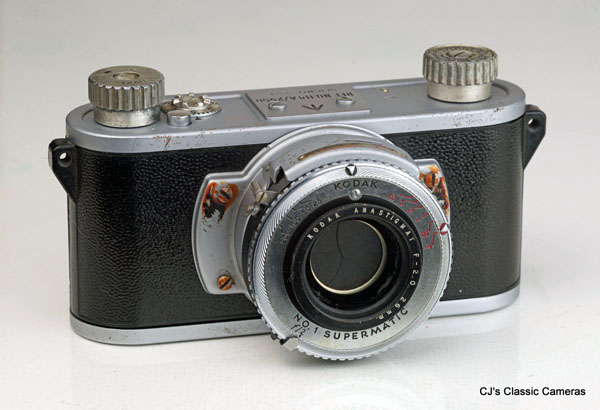
A viewfinder-less Kodak 35 with a rather unique 26mm f/2 Anastigmat lens, used by the British military. The 26mm is an unusual lens, it's located in its entirety behind the shutter, whereas in front of the shutter there is a thick piece of clear plain glass, which is difficult to see in the photo. The lens itself could not be focussed and had no aperture. The Supermatic shutter did have an aperture control, but since it was located in front of the lens, using it would mainly result in strong vignetting.
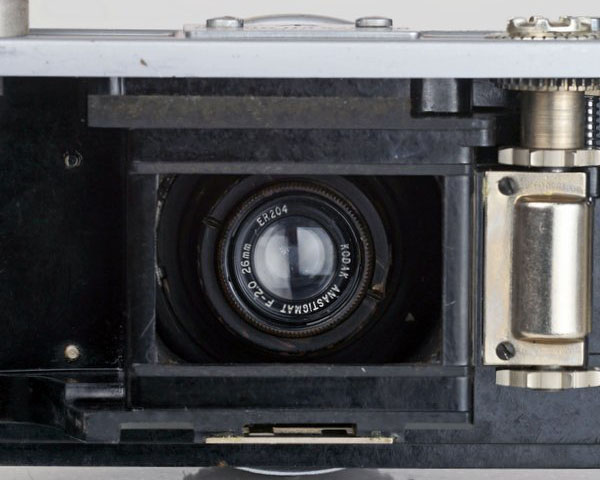
Rear view of the military Kodak 35, showing the back (or front? it looks reversed) of the 26mm lens, which intruded quite far into the camera. The image doesn't actually cover the film frame, it just about covers it from top to bottom, so the image you would get is round and grading into a black background. To get a rectangular image, you'd have to enlarge the centre, which would result in a similar image as you'd get with a normal lens on full frame. Apparently this camera was used to photograph circular radar screens, for which the round image nor the very shallow depth of field of the f/2 aperture or the lack of a viewfinder would be an issue.
I've been breaking my head, though, why a normal lens wasn't used. I reckon it's because a 26mm lens with a fast aperture is easier to make than a normal lens (similar to video cameras that often have very short focal lengths but fast apertures) and full frame coverage wasn't needed. A full frame lens of the same speed would have been much larger and the camera would need to be further from the screen. The fast aperture was probably needed due to the dim radar screens and the slow film speeds common at the time.
On a final note, the lens serial number indicates it dates from 1945, so these cameras must have been used shortly after the end of WWII.
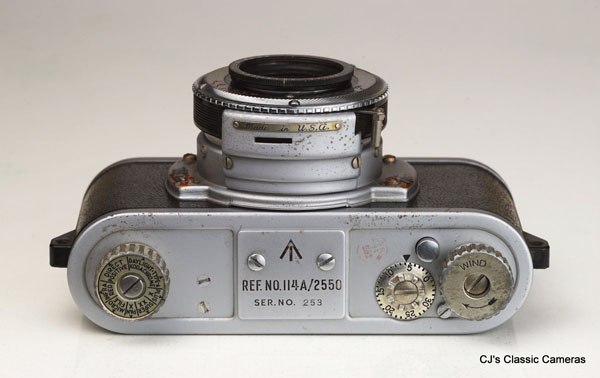
Top view of the military Kodak 35 showing the British Army identification plate where one would normally find a viewfinder. I've been trying to decipher the code (Ref. No. 114A/2550), it appears that nr. 14A generally referred to photographic equipment, and that the prefix 1 means it was manufactured in the USA. I have a Kodak Medalist also used by the British military with the same ref no. 114A. The number 2550 is like a catalogue number and specific for this particular type of cameras, of which the military had quite a few, based on the serial nr. also shown (which differs from the camera serial nr. inside the body).
Kodak 35 RF
The Kodak 35 also came as a rangefinder version. It had a large contraption with gear wheels built around the lens and was big, heavy and, well, plain ugly. There certainly was little left of the sleek look of its viewfinders cousins shown above. The rangefinder was of the split mirror type and was magnified to increase accuracy, therefore a separate viewfinder was also present. A gear wheel next to the lens could be used to focus the lens, although its benefit over turning the actual lens is not quite clear to me. Perhaps it was to avoid holding your hand in front of the rangefinder window while focussing. The shutter was released by a small lever on the shutter housing itself, the small button next to the wind knob was there only to reset the wind lock mechanism.
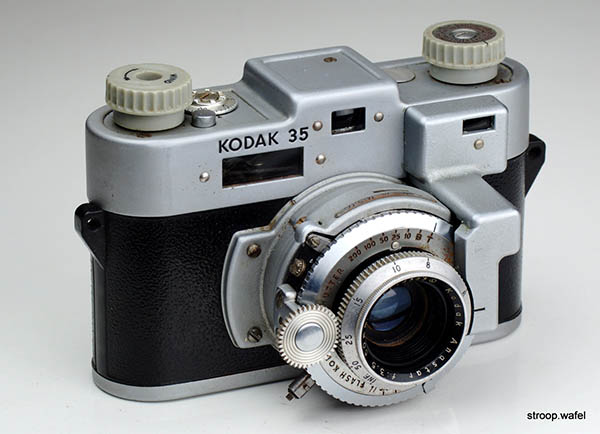
Rangefinder version of the Kodak 35 50mm f/3.6 Kodak Anastigmat lens in Kodex Flash shutter. Probably one of the uglier cameras in my collection!
Kodak Medalist / Medalist II
The Medalist is one of the most impressive cameras Kodak ever build, and not just because of its sheer size and weight (nearly 1.5 kg!). The Medalist was a medium format 6x9 rollfilm camera, but whereas nearly all other cameras using this format were folding cameras, the Medalist had a rigid body with a telescopic lens with double helical focussing mechanism. The only other camera I know to have a similar focussing mechanism was the Ihagee Parvola, shown here. In addition, the Medalist had a rather unique rangefinder system: it had a single eye-piece at the back which showed two images above each other: a viewfinder image on top with a split-screen rangefinder benath. The latter showed an enlarged section of the centre of the viewfinder window; due to its high magnification and wide base the rangefinder was highly accurate.
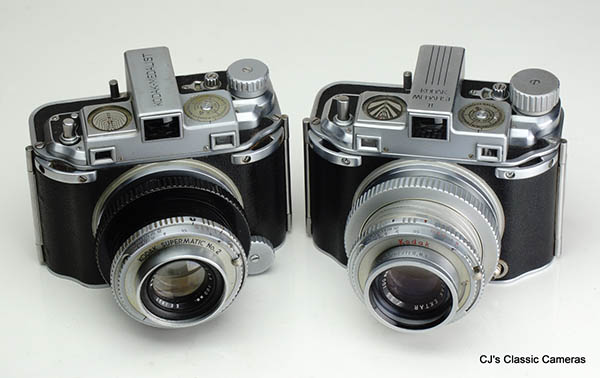
A 1944 Kodak Medalist and a 1949 Medalist II, both with Kodak Ektar 100m /f/3.5 lens.
Another innovative feature was the wind mechanism, which automatically cocked the shutter and also contained a wind lock to stop the film once it had been advanced far enough, thus negating the need for a spy window. A spy window was still present but it was only needed to advance to film to its first exposure. Last but not least, the camera's back could be removed and replaced with a film back or with plate holders.
All in all this was a remarkable set of features for a camera that was developed during WWII, initially for military use. The camera was fast, reliable and accurate, and build like a tank. But it was the five-element 100mm f/3.5 Ektar lens that really made its reputation. It was extremely sharp and is still regarded as one of the great lenses from that era.
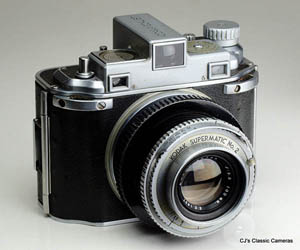
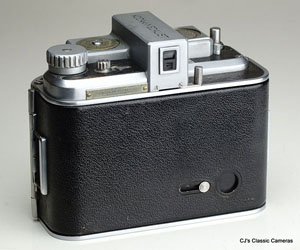
Front and rear views of the Kodak Medalist. Move the mouse over the pictures to see a comparison with the Medalist II, which only differed in detail. As a side note, the film gate of the Medalist measured 56x81mm, thus a little smaller than the nominal 9x6cm, but still five times larger than regular 35mm film!
A few years after the first Medalist, the Medalist II was introduced. It only differed from the first model in detail, e.g., the double-helical lens was silver anodized instead of black, the fine focus knob at the front beneath the lens was removed and flash synchronisation was added to the shutter. In addition, its Ektar lens was coated.
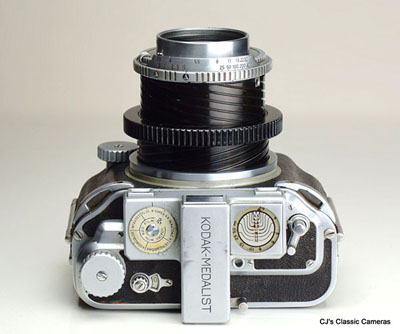
|
Top view of the Kodak Medalist I with its lens fully extended to its shortest focus distance of 3.5 ft, as can be seen on the focus indicator right of the viewfinder.
|
Despite all the impressive features the camera had only a fairly short production run of a few years, after which is was updated to the Kodak Chevron (see below). The latter did not really catch on, like the Medalist it was large and heavy, which really made it a specialist camera. Nevertheless, the Medalist showed that the American division of Kodak was capable of building equally impressive cameras as its illustrious German counterpart.
As a final remark, the both Medalist models used 620 film, which is similar to 120 film but with narrower spool and flanges. As 620 film is no longer available one needs to respool 120 film onto 620 spools to be able to use the camera. Well worth the effort!
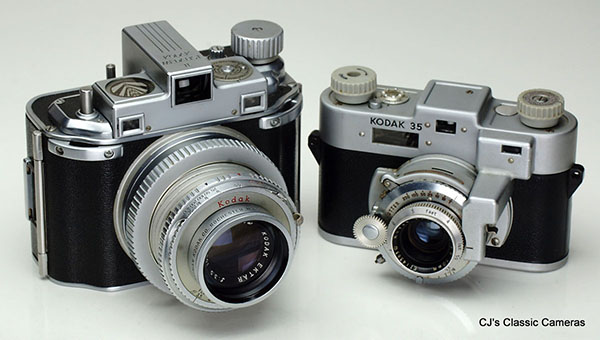
A Kodak Medalist II next to its smaller sibling, the Kodak 35 RF, itself not a particular small 35mm camera, just to give some idea of the size of the Medalist. Also note their similarity in design.
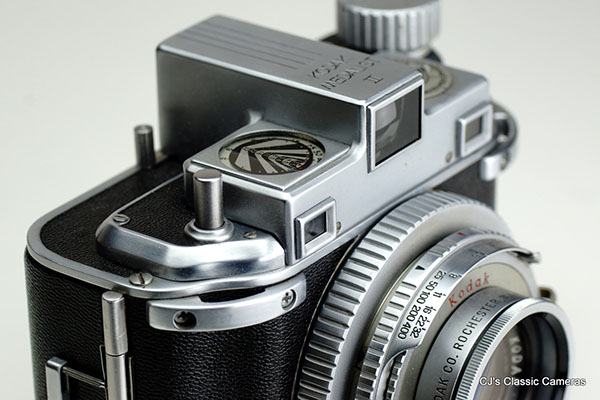
Close-up of the Kodak Medalist II showing this magnificent behemoth from what is probably its best angle.
Kodak Chevron
The Chevron was a 6x6 medium format camera for 620 meant to replace the Kodak Medallist described above. The Medalist was a big and heavy camera, and ironically, despite having a smaller film format, the Chevron was about the same size and weight as its predecessor. Functionally it was very similar but it had a new look more similar to other Kodak's from that time such as the Kodak Signet 35 below. The characteristic double helical focusing of the Medalist disappeared. The rangefinder had a similar design as the Medalist with an enlarged split screen mirror image visible together with the regular viewfinder image.
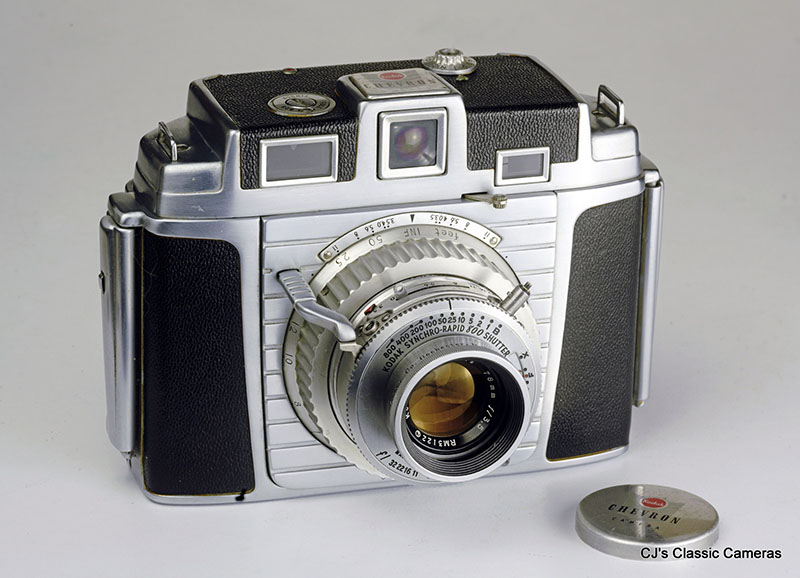
A Kodak Chevron with Kodak Ektar 78mm f/3.5 lens in Kodak Synchro-Rapid 800 shutter. The lens coating had a characteristic honey-brown colour instead of the dark blue of the Medalist, which I think is due to it being multicoated.
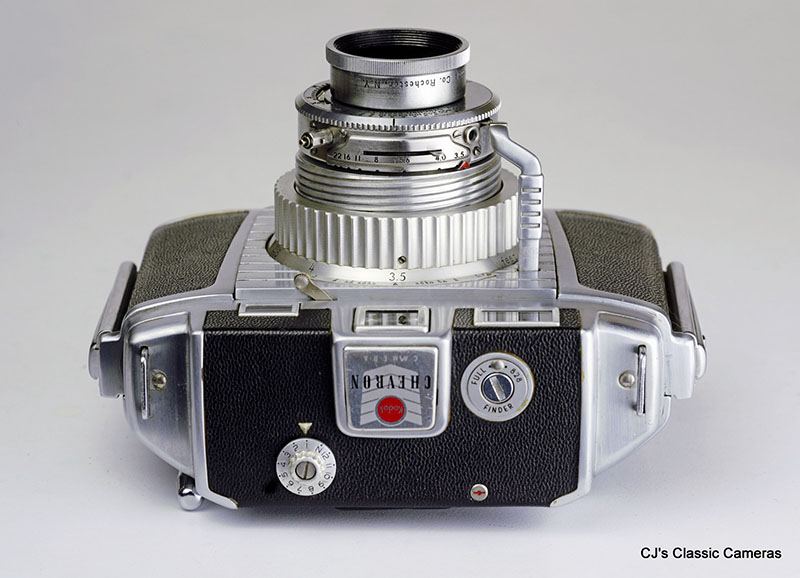
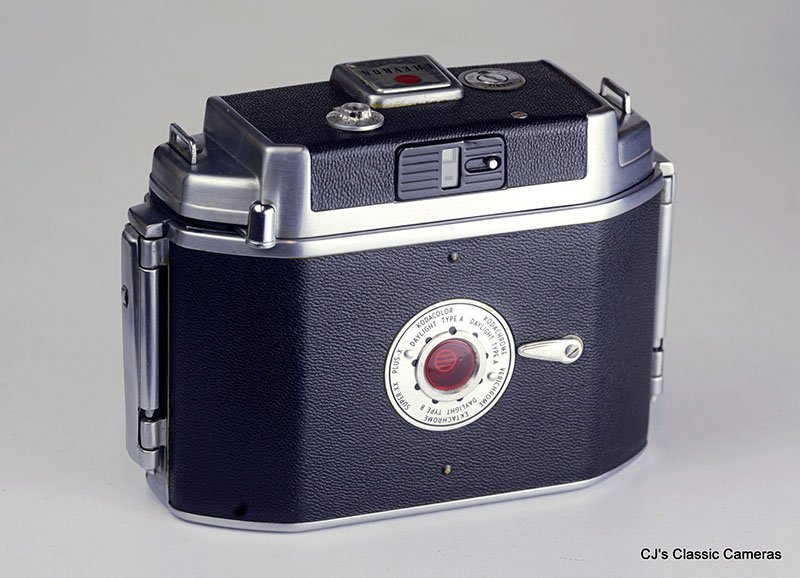
Top and rear view of the Kodak Chevron. The back was removable for easy loading. The top had a switch for full or 828 finder view. The latter was for use with 828 film, which has the same size as 35 mm stock but is a rollfilm with no perforations. Using this film format would result in the 78mm lens functioning as a short telelens.
Kodak Signet 35
The Kodak Signet 35 was a peculiarly styled but high quality camera built by the American division of Kodak as the replacement for the Kodak 35 RF. It featured a coupled rangefinder, helical focussing and a Kodak Ektar 44mm f/3.5 lens with a Tessar design. All controls including the wind knobs are rather large and the story goes that it was designed so one could operate it with gloves on. On the downside the Kodak Synchro shutter had to be cocked by hand and had a limited speed range. It was built between 1951 and 1958.
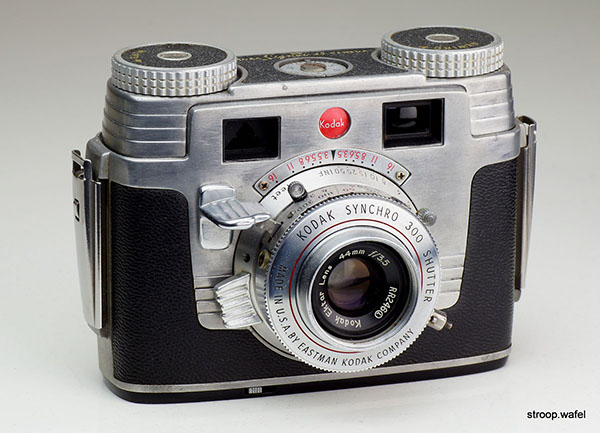
A Kodak Signet 35 with its rather mouse-like features but build to last.
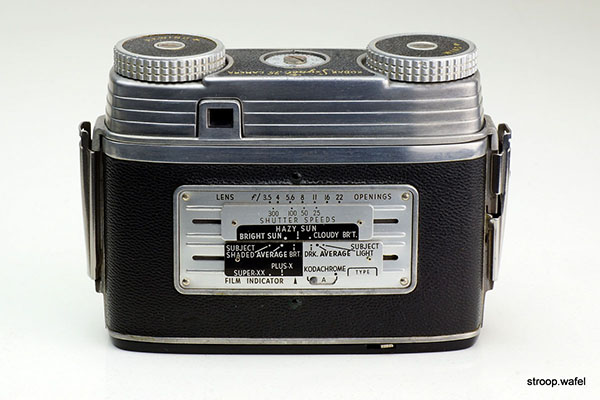
The back of the Kodak Signet 35 had a sliding exposure calculator.
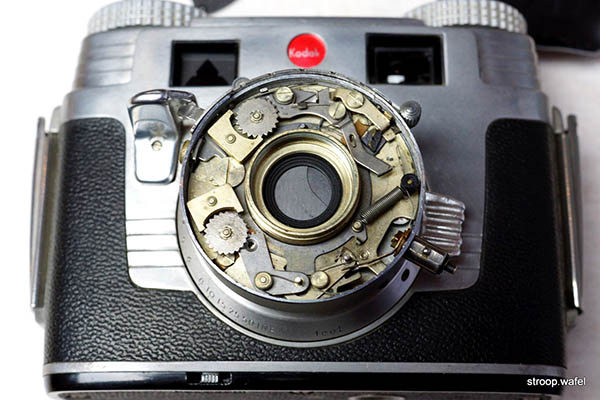
Kodak Synchro 300 shutter opened up, quite a different design than contempary Prontor and Compur shutters.
Kodak Bantam RF
The Kodak Bantam RF was made from 1953-1957 and thus a contemporary of the Signet 35 above. Like earlier Kodak Bantam cameras, it was designed to use 828 roll film, and probably one of the last cameras to do so. Read more about 828 film on my Photavit 828 page.
The Bantam RF was one of the better specified 828 cameras, which were usually at the cheaper end of the camera market. As the name indicates, it had a rangefinder, which was coupled to the focus mechanism. This is actually one of the better features of the camera, as the rangefinder is bright and contrasty. In addition the camera was flash-synchronised and had a decent lens. The film advance system worked automatically, so despite the Bantam RF being a roll film camera, one did not have to use a spy window at the back (although one was present just in case). It was a little disappointing though, that one still had to cock the shutter by hand.
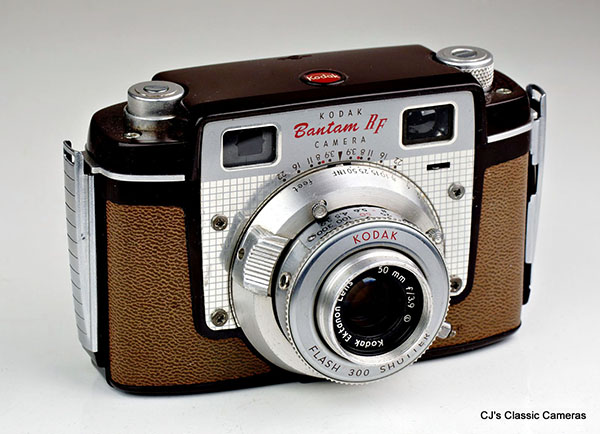
Kodak Bantam RF with Kodak Ektanon 50mm f/3.9 lens in FLash 300 shutter.
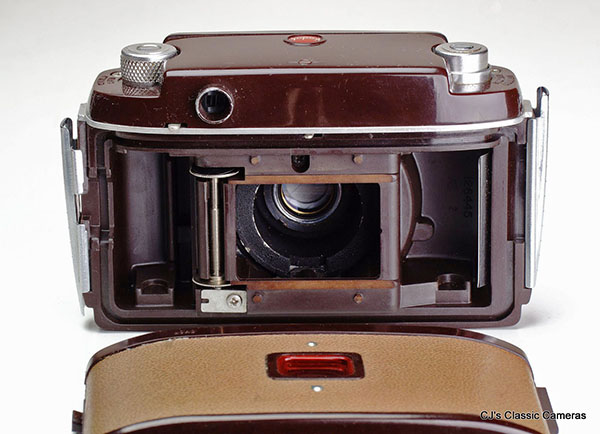
Rear view of the Kodak Bantam RF with back removed, showing the film chamber. Note there is no uptake spool, as 828 film is a rollfilm, and that instead of a film sprocket there is a 'spikey wheel' to monitor how far the film has been advanced for each frame.
Kodak Stereo
The Kodak Stereo was introduced in 1954 during the heydays of stereo photography. It wasn't as advanced as some of its competitors, e.g., it lacked a rangefinder and it had only a limited range of shutter speeds, but it was easy to use with clear instructions printed on the various bits of the camera, and it did have a build-in spirit level, which was a nice feature. It was also light, being made mainly of bakelite.
Kodak also made several stereo slide viewers and provided a stereo slide mounting services, all helping making this camera a great success.
This was not the only foray of Kodak into stereo photography, they also produced a stereo attachment to be used with Kodak Retinas (see here) and a matching stereo slide viewer. Note however that this setup resulted in two halfframe photos (one stereo pair) on a single 36x24mm frame, whereas the Kodak Stereo would make two different 24x24mm photos simultaneously.
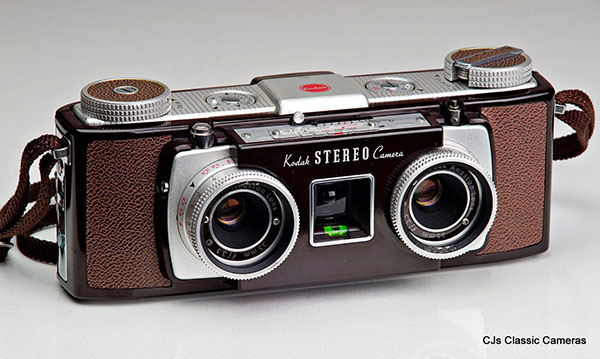
Kodak Stereo with two Anastigmat 35mm f/3.5 lenses. The viewfinder is located in-between the lenses, avoiding any parallax issues. The spirit level is visible through the viewfinder, making it easy to keep the camera straight.
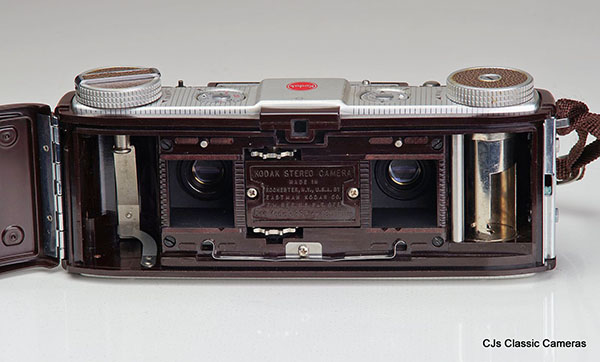
Rear view of the Kodak Stereo showing the inside of the camera. Note the notches at the bottom of the film frames, that way one could tell which was the 'right' photo of each stereo pair and which one the 'left' .
Kodak Six-20 'Brownie' C
Kodak made its early fortunes with box cameras (and the film to use them) and continued to build them throughout most of its long history in a wide range of different models without changing much to their basic concept. The Six-20 Brownie C was one of those. It was very basic, having a single shutter speed and a fixed focus lens. It used 620 film and had a large 6x9 cm frame size, although the photos the camera produced were more suitable for contact prints than enlargements.
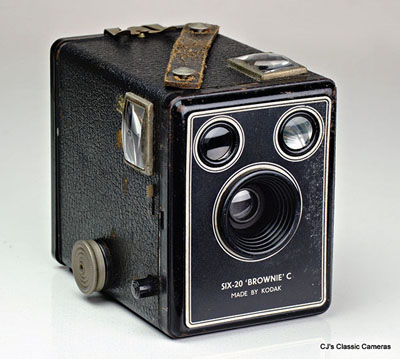
| |
Kodak Six-20 'Brownie' C, one of the ubiquitous Brownie's Kodak made. This is an early model from between 1946 and 1953, the later model had a different black and white striped front face.
|
Kodak 'Brownie' 127
The Kodak Brownie 127 was a simple bakelite camera for 127 rollfilm produced almost exclusively in and for the UK. They were very
popular, several millions must have been build and they are cheap and plentiful on eBay. They were easy to operate, having a fixed lens with single aperture and shutter speed. The only two controls, release button and wind knob, were clearly indicated in bright colours so were hard to miss. Of course, one still had to look through the spy window at the back to make sure the film was wound far enough. It had a meniscus lens of ca. 60mm focal length and a curved film plane for a 6x4 film frame, hence it was a 'full frame' 127 camera compared to most other 127 cameras with 3x4 cm frames. After eight shots the film was full.
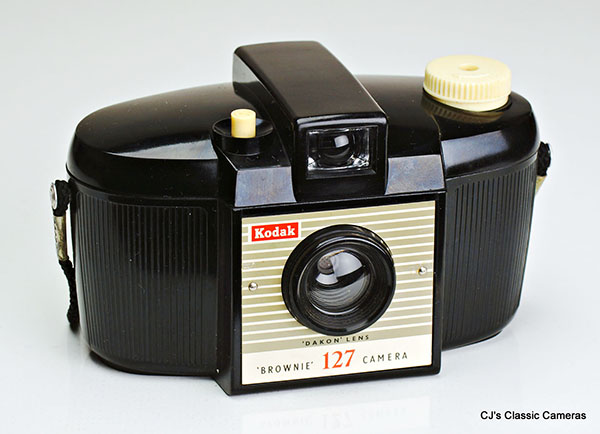
Kodak 'Brownie' 127 camera with Dakon lens. This is the second version, introduced in 1959 and recognisable by the vertical stripes on the body as well as the larger viewfinder.
| 
